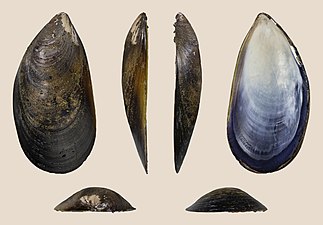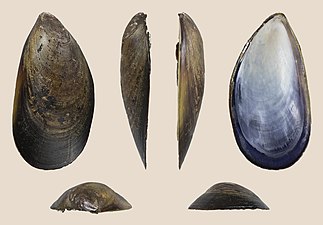en
names in breadcrumbs


The Chilean mussel[1] or Chilean blue mussel[2] is a species of blue mussel native to the coasts of Chile from Biobío Region (37 ºS) to Cape Horn (55 ºS). Today genomic evidence confirmed that the native Chilean blue mussel is genetically distinct from the Northem Hemisfere M. edulis, M. galloprovincialis and M. trossulus[3] and also genetically different from Mytilus platensis",[4] the other species of smooth shelled mussel from Southamerica.
M. chilensis is under intensive aquaculture in Chile. From 2004 to 2008 the annual commercial harvest increased from 80,000 to 200,000 tonnes.[5] Following a decrease in 2009, the production was back at high level in 2010.[6] Over 45,000 tonnes of mussels were exported from Chile in 2008, 93% of them frozen. Some 74% of exports are to the EU, primarily Spain and France, and 15% to the United States.[5]
Alcide d’Orbigny first described the species Mytilus platensis d'Orbigny, 1842,[7]. Species that was for many year erroneously confused with Mytilus chilensis described by Hipolito Hupé in 1854.[8] Nowadays most biodiversity data bases, such as the World Register of Marine Species [9] or the Integrated Taxonomic Information System [10] recognise Mytilus chilensis as a valid taxon in the Mytilus genus and different from Mytilus platensis. Mytilus chilensis is part of the worldwide Mytilus edulis complex of mussels, or blue mussels. Modern genetic studies based on single-nucleotide polymorphism (SNP) have demonstrated that the Chilean mussel is genetically different of both the Mediterranean mussel (Mytilus galloprovincialis) and the North Atlantic Mytilus edulis. Evidence collected until 2021 recognized several blue mussel species in South America, including native M. platensis, introduced M. galloprovincialis from the Mediterranean, and possibly-introduced M. planulatus.[11][12] Using nuclear DNA markers, Borsa et al. (2012) confirmed earlier results from allozymes[13] that most populations in the south of the South American continent indeed represent a native Southern Hemisphere lineage of the blue mussel, for which they suggested to use the subspecies name Mytilus edulis platensis[11] (now M. platensis). The same authors questioned the earlier identifications of the Montevideo mussel in Southern Chile as "M. galloprovincialis"[2] because the genetic markers then used could not help distinguishing M. galloprovincialis from any of the two native blue mussel species from the Southern Hemisphere,[11] now referred to as M. planulatus and M. platensis. Moreover, M. platensis populations in southern Chile show slight introgression from M. planulatus.
{{citation}}: CS1 maint: multiple names: authors list (link) {{citation}}: CS1 maint: multiple names: authors list (link) {{citation}}: CS1 maint: multiple names: authors list (link)[2] {{citation}}: CS1 maint: multiple names: authors list (link)[3] The Chilean mussel or Chilean blue mussel is a species of blue mussel native to the coasts of Chile from Biobío Region (37 ºS) to Cape Horn (55 ºS). Today genomic evidence confirmed that the native Chilean blue mussel is genetically distinct from the Northem Hemisfere M. edulis, M. galloprovincialis and M. trossulus and also genetically different from Mytilus platensis", the other species of smooth shelled mussel from Southamerica.
Right and left valve of the same specimen:

Right valve

Left valve